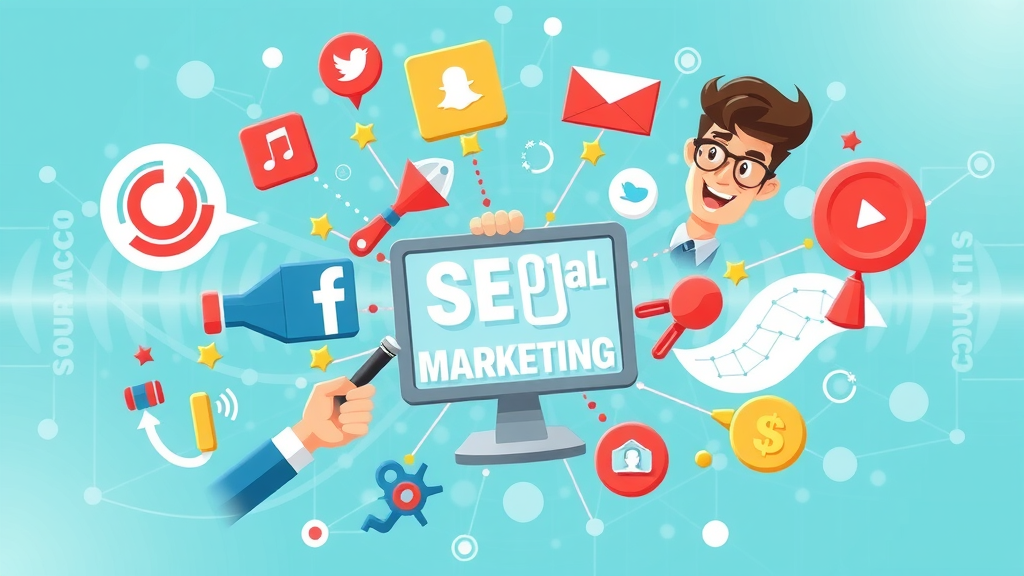
Startling Truths: Why Avoiding Digital Marketing Mistakes is Mission Critical
- Did you know 40% of digital marketing budgets are wasted on ineffective strategies every year ? This article reveals the most costly digital marketing errors—and how to sidestep them for success.
Digital marketing has transformed how brands compete, with both opportunities and pitfalls around every corner. If you’re steering your business into the digital landscape without clear strategy, you’re not just leaving money on the table—you’re at risk of falling behind the competition entirely. With technologies moving faster than ever and consumer habits shifting with each algorithm update, the smallest misstep in your digital marketing strategy can lead to outsized consequences, from depleted marketing budgets to lost brand awareness . In today’s hyper-connected world, understanding which digital marketing mistakes to avoid is not just smart—it’s essential for survival.
Throughout this guide, you’ll discover why so many brands—big and small—struggle with wasted ad spend, missed customer engagement, and poor ROI. But more importantly, you’ll gain practical insights, actionable solutions, and expert-backed approaches to ensure your digital marketing efforts deliver results and keep you ahead in 2024 and beyond.
Understanding Digital Marketing: Definitions, Channels, and Why Mistakes Matter
- Clarifying what digital marketing means today: At its core, digital marketing refers to leveraging online channels to promote products or services using digital technologies. This encompasses a wide array of strategies, from SEO and paid ads to content and social tactics.
- Breaking down core digital marketing channels: The primary marketing channels include social media, email marketing , search engine optimization ( SEO ), paid advertising, and more. Each marketing channel serves a unique function, and their synergies are what drive successful campaigns.
- Why every business must adapt: The digital landscape is dynamic, and consumer attention is scattered. Failing to adapt your marketing strategy to current trends, tools, and platforms can result in missed opportunities and diminishing brand awareness , especially as search engines and social media algorithms continue to evolve rapidly.

What You'll Gain From This Digital Marketing Guide
- Insights into the most common digital marketing mistakes
- Actionable steps to improve your digital marketing strategy
- Examples from marketing pros and digital market leaders
- Lists of do’s & don’ts for every major marketing channel
By the end of this guide, you’ll have a toolkit for diagnosing what’s gone wrong in your campaigns—and a roadmap for what to do instead. We’ll break down the data and stories from digital marketers at the top of their field, share proven techniques, and equip you with checklists and tables you can return to again and again. Whether you’re crafting a new campaign or refining your existing efforts, this resource is designed to help you maximize ROI and cut through digital noise.
Core Elements of a High-Performing Digital Marketing Strategy
Combining Social Media and Email Marketing with Content Marketing

Successful digital marketing in 2024 is a holistic endeavor— social media , email marketing , and content marketing must work in concert to deliver consistent messaging and audience engagement. Social media platforms are vital for building communities, sparking conversation, and gaining immediate feedback. Meanwhile, email serves as your most direct line to existing fans and customers, allowing for personalized outreach.
But these elements shine brightest when they’re tied together by engaging content marketing . Think of your blog posts, infographics, videos, and newsletters as the fuel that powers both email and social engagement . For example, a well-crafted tutorial shared via a social feed can generate excitement, while a follow-up email series can deepen trust and move prospects down the funnel. The more your channels complement each other, the more likely you are to achieve measurable success with your overall digital marketing strategy .
Choosing The Right Marketing Channels For Maximum Reach
With dozens of platforms and ad types available, it’s tempting to spread your digital marketing efforts thin. However, smart digital marketers know that choosing the right marketing channels is about targeting where your audience lives and interacts most. For a B2C fashion brand, Instagram and TikTok might provide unmatched reach, while a B2B SaaS provider may find LinkedIn or Google Ads deliver higher-quality leads.
Investing time to analyze channel-specific trends, test small campaigns, and track results will help you refine your digital marketing strategy and sidestep one of the most common traps: trying to be everywhere at once. Instead, focus your energy where it counts, iterating as consumer behaviors change and new media platforms emerge.
Leveraging Search Engine Optimization for Brand Awareness
Search engine optimization (SEO) is the backbone of organic digital growth. An investment in SEO helps position your content and offerings atop search engine results, growing your brand awareness around the clock without excessive paid ad spend. But SEO isn't just about keywords—modern search engine algorithms reward quality, relevance, and user experience.
Integrate SEO into every piece of content you produce, from landing pages to blog articles and product descriptions. The key is sustained effort: analyze competitor keywords, focus on optimizing for mobile devices, and monitor your rankings over time. As you strengthen your brand’s visibility on search engines, you’ll lay a foundation for long-term growth that no individual ad campaign can match.
“Strategy without tactics is the slowest route to victory. Tactics without strategy is the noise before defeat.” – Sun Tzu
| Aspect | Traditional Marketing | Digital Marketing |
|---|---|---|
| Metrics | Hard to measure (impressions/circulation) | Highly measurable (clicks, conversions, engagement) |
| Reach | Local, regional, or national | Global, real-time, targeted |
| Cost | High (print, TV, radio) | Flexible (PPC, CPM, SEO, social free/paid) |
| Flexibility | Low (static campaigns, slow feedback) | High (instant edits, A/B testing, dynamic) |
Digital Marketing Mistakes: The Top Errors to Avoid in 2024
Ignoring Data-Driven Marketing Strategy and Analytics
In today’s data-rich environment, ignoring the insights your analytics provide is one of the most costly digital marketing mistakes. Brands that don’t embrace a data-driven approach often waste budget on ads and channels that simply don’t convert. Marketing campaign performance should never be a guessing game; routinely analyzing metrics allows marketing managers to adjust in real time, ensuring you’re maximizing every dollar.
Whether you're running paid ads , organic social media campaigns, or email sequences, review analytics dashboards regularly to spot drop-offs, optimize conversion points, and reallocate resources effectively. Successful digital marketers track not only traffic and clicks but also engagement, shares, open rates, and revenue impact.
Neglecting Mobile Optimization in Digital Marketing Campaigns
With most web traffic now originating from mobile devices , failing to optimize for mobile is a cardinal sin in digital marketing. If your website, emails, or ads perform poorly on smartphones or tablets, your prospects will simply bounce to competitors who provide a better user experience.
Always adopt a mobile-first mindset—test your content on various mobile devices and prioritize responsive design. Ensure fast loading speeds, legible font sizes, and clickable CTAs. In today’s landscape, a mobile app or progressive web experience can become a brand differentiator, boosting repeat visits and brand awareness across every digital marketing channel .

Overlooking the Impact of Social Media Marketing Missteps
An inconsistent or tone-deaf social media marketing approach can erode your reputation quickly. Consumers look for brands that communicate authentically, post regularly, respond to comments, and align with current trends. Negative or ignored feedback on social media can spiral into PR nightmares in hours.
Avoid the mistake of treating social accounts as a broadcast channel; instead, cultivate two-way conversations and provide genuine value. Monitor media platforms for trending topics, leverage user-generated content, and experiment with video and interactive posts to increase engagement and brand awareness .
Failing to Invest in Search Engine Optimization and Content Marketing
Too many brands still rely solely on paid ads, but search engine optimization and content marketing remain the highest-ROI tactics in any digital marketing strategy . Ignoring SEO audit routines, publishing thin content, or overlooking keyword opportunities leaves organic traffic on the table.
Invest in a robust editorial calendar that prioritizes quality, relevance, and topical authority. Combine evergreen blog posts, “how-to” guides, and visual assets to build a content moat competitors can’t easily replicate. Over time, these efforts lead to compounding organic growth and stronger digital foundations.
Choosing the Wrong Marketing Channels for Your Audience and Objective
Not every marketing channel is created equal—what works for a young, tech-savvy audience may flop with retirees or professionals. Diving into new media platforms without research means missing out on tailored opportunities and wasting budget.
Define your target persona, analyze platform demographics, and match your marketing strategy to the nuances of each channel. Continual testing and refinement will help you allocate resources to the channels that matter most.

Not Defining a Target Audience in Your Digital Marketing Approach
Pursuing all users means engaging no one. The biggest mistake digital marketers make is failing to define, research, and continually refine their target audience. Without this clarity, your creative and ad spend are spread thin, with generic messaging that fails to connect.
Use segmentation, audience personas, and deep analytics to guide every aspect of your digital marketing campaigns . Knowing your ideal customer empowers your team to produce content, ads, and outreach that truly resonate.
Disregarding the Power of Influencer Marketing and Affiliate Marketing
In a trust-driven market, influencer marketing and affiliate marketing have skyrocketed as high-ROI approaches to cut through noise and build credibility. Neglecting these methods means missing audiences gathered by industry micro-influencers, trusted creators, and expert partners.
Invest in authentic collaborations and clear partnership programs to leverage third-party voices. A single partnership with a well-aligned influencer can yield more conversions than months of self-promotion, especially in visual and niche-driven verticals.
Lack of Regular Review and Adaptation in Digital Marketing Strategy
Digital trends change by the week, if not the day. Brands that don’t embed continuous learning—and regular strategy audits—into their culture inevitably get left behind. A lack of review means missed innovations, persistent underperformance, and falling victim to algorithm shifts.
Build quarterly review processes, monitor competitor moves, and always be ready to iterate on current campaigns. Those who adapt fastest thrive in the ever-shifting digital landscape.
“Ignoring online marketing is like opening a business but not telling anyone.” – KB Marketing Agency
Building and Refining an Effective Digital Marketing Strategy
How to Audit Your Existing Digital Marketing Efforts

Conducting a thorough audit is the first step toward an optimized digital marketing strategy . Start by reviewing all current campaigns across each marketing channel : website, social media , email marketing, SEO, and paid ads. Identify which assets drive the most leads, engagement, or sales, and note those lagging behind.
Look for gaps such as missing meta tags, broken links, a lack of mobile optimization, or sluggish page load times—all of which can cost dearly in both traffic and conversions. Gather baseline KPIs so you’ll be able to measure improvements as you refine your strategy over time.
Setting Clear Objectives and KPIs for Digital Marketing Success
Vague ambitions like “grow our brand” don’t cut it in the digital era. Establishing SMART goals—clear, measurable, achievable, relevant, and time-bound—is non-negotiable for modern marketing managers . Define exactly what success looks like for each channel: increased traffic, higher email open rates, more conversions, lower cost-per-acquisition.
Map these objectives to concrete KPIs and review them weekly or monthly. By aligning daily tactics to big-picture goals, you move from scattered campaigns to a focused, ROI-driven digital marketing strategy .
Integrating Content, Email, Social Media & Paid Media Marketing
Integration is the name of the game. Your content marketing efforts should seamlessly flow into your email campaigns , amplify in social media marketing , and, when appropriate, be supported by targeted paid media. For every campaign, plan touchpoints across the channels your customer travels—from awareness (blogs, social posts) to conversion (retargeting ads, email offers).
Cross-channel strategies don’t just reinforce your message—they invite prospects to engage with your brand in whichever context feels most natural. This approach creates brand consistency, increases visibility, and improves conversion rates at every stage of the marketing funnel.
-
Checklist: 10-point digital marketing campaign audit for beginners
- Review goals and KPIs for each channel
- Check website/mobile speed and responsiveness
- Audit SEO: keywords, tags, and backlinks
- Track engagement on social media platforms
- Analyze email open and conversion rates
- Assess paid ads for ROI
- Test mobile device experiences
- Evaluate content quality and relevance
- Segment audience and personalize messaging
- Schedule regular reporting and analysis
The Essential Marketing Channels Every Digital Marketer Should Master
Social Media and Media Platforms: Differences, Trends, and Pitfalls

Social media is a sprawling landscape, with ever-evolving media platforms like Facebook, Instagram, Twitter, TikTok, and LinkedIn each offering unique opportunities and risks. Mastering these channels requires more than just posting frequently—it demands understanding the audience culture, leveraging trends, and tracking real-time analytics.
Pitfalls include algorithm changes, negative feedback loops, and viral missteps that can hamper brand awareness . Stay informed of platform updates, experiment regularly, and maintain a crisis plan for digital slip-ups.
The Role of Email Marketing in Modern Digital Marketi
Email marketing remains a cornerstone for building lasting customer relationships. Unlike public platforms, email gives brands direct access to their audience’s inbox for personalized messages, announcements, and offers. Smart segmentation and compelling copy are essential—segmented campaigns average significantly higher open and conversion rates.
Don’t overlook automation: use triggered email sequences to nurture prospects at various funnel stages. Make use of analytics to refine timing, subject lines, and content. Email’s high ROI justifies ongoing investment as part of any digital marketing strategy .
Affiliate and Influencer Marketing: Power Partnerships
Affiliate marketing and influencer marketing tap into established audiences built by others. Affiliates—typically bloggers or business partners—drive traffic to your offerings in exchange for a commission, while influencers provide social proof by authentically sharing your brand.
Build scalable programs by offering competitive incentives, supporting affiliates and influencers with creative collateral, and tracking performance metrics rigorously. The result: your brand extends its reach and trust without massive ad expenditures.
SEO and Search Engine Optimization: Driving Sustainable Growth
Effective search engine optimization is non-negotiable for sustainable digital growth. Start by auditing your site for technical issues, researching high-impact keywords, and continually publishing authoritative, search-intent-focused content.
Monitor your performance on search engines like Google and Bing, adjusting content strategies and backlink outreach as algorithms evolve. As your search rankings climb, so does your ability to consistently attract new prospects and build brand awareness with minimal recurring costs.
Maximizing Brand Awareness Through Digital Marketing Tactics
Creating Compelling Content Marketing for Digital Marketi

Great content marketing transforms passive browsers into engaged fans and advocates. Focus on solving problems, entertaining, or educating—your value proposition should be woven into every piece, from blog posts and eBooks to videos and podcasts.
Use storytelling, eye-catching visual design, and strong CTAs to prompt sharing and conversation. The best digital brands are known for highly shareable, visually consistent, and useful content that can be repurposed across channels for maximum reach and brand awareness .
Tracking and Enhancing Brand Awareness with Analytics
To accurately measure brand awareness , track KPIs such as impressions, reach, branded search volume, share of voice, and social mentions. Utilize Google Analytics, built-in social platform dashboards, and third-party tools to monitor sentiment and engagement trends.
Periodically survey your audience to gauge brand recall and perception shifts. Use these insights to refine creative, campaign targeting, and channel mix for even better results.
Smart Use of Social Media Marketing for Visibility and Engagement
Social media marketing is more than broadcasting messages—it’s about building authentic relationships and encouraging real conversations with your fans. Tailor your content to fit the culture and best practices of each platform: short-form videos for TikTok, live discussions for Facebook, and thought leadership on LinkedIn.
Launch contests, engage with trending topics, and respond promptly to feedback to foster trust and boost engagement. Consistency and responsiveness are what separate digital marketing leaders from followers.
| Channel | Average Conversion Rate | ROI Potential |
|---|---|---|
| Email Marketing | 16-20% | High |
| SEO | 12-15% | High |
| Paid Ads (Google/Facebook) | 6-10% | Moderate to High |
| Social Media Organic | 1-4% | Moderate |
| Affiliate/Influencer | 7-12% | High |
“Content is fire; social media is gasoline.” – Jay Baer
Mistakes to Avoid for Success as a Digital Marketer
- Overcomplicating Your Digital Marketing Strategy
- Ignoring Emerging Media Platforms
- Neglecting Continuous Learning & Industry Trends
- Failing to Adjust Marketing Channel Allocation
Simplicity, agility, and dedication to learning are your best friends in the evolving digital marketi landscape. Don't try to do everything at once or cling to outdated marketing strategies . Focus on what offers real value to your audience and continually adapt as new platforms, tools, and trends arise.
Expert Insights: Pro Tips for Digital Marketing Success

Top marketing pros agree: The best digital marketers combine data, creativity, and a willingness to experiment. Don’t aim for perfection—aim for progress through rapid testing and honest review. Monitor emerging technologies, automate where possible, and invest in professional development. Use failures as feedback. And above all, keep your focus squarely on serving your audience better than your competitors.
Cross-pollinate ideas between channels, repurpose your highest-performing content, and foster a culture that celebrates improvement. With these habits, your digital marketing becomes not just a cost center—but a true growth engine.
“The best marketing doesn’t feel like marketing.” – Tom Fishburne

(Video concept placeholder: This animated explainer shows how wasted budgets and ignored analytics can lead to digital marketing failure. In contrast, a data-driven, customer-first approach delivers lasting results and measurable success stories.)
(Video concept placeholder: Watch leading brands turn ordinary stories into viral social media gold, using smart content marketing strategies and perfectly-timed engagement to drive massive brand awareness.)
People Also Ask
What does a digital marketer do exactly?
- A digital marketer plans, develops, and executes digital marketing campaigns across search engines, emails, content platforms, social media , and paid ads. Their main goal is to increase brand awareness , generate leads, and drive conversions through digital channels.
What are the 4 types of digital marketing?
- The four main types of digital marketing are:
- Search Engine Marketing (SEM)
- Social Media Marketing
- Content Marketing
- Email Marketing
How do I start my digital marketing?
- To start your digital marketing journey:
- Define your business goals and target audience
- Choose suitable marketing channels (social media, SEO, email)
- Develop a content marketing plan
- Launch small-scale campaigns, measure results, and refine continuously
What are the 7 types of digital marketing?
- The seven types of digital marketing are:
- Search Engine Optimization (SEO)
- Search Engine Marketing (SEM)
- Content Marketing
- Social Media Marketing
- Email Marketing
- Affiliate Marketing
- Influencer Marketing
Frequently Asked Questions
-
What’s the difference between digital marketing and online marketing?
Online marketing focuses solely on Internet-based strategies, while digital marketing covers Internet strategies and other digital technologies (like mobile apps and digital billboards). -
What’s the most common digital marketing mistake?
Not defining a clear target audience or marketing strategy is the most frequent (and costly) oversight.
Key Strategies to Future-Proof Your Digital Marketing
- Stay current on marketing pro insights
- Use analytics to guide every marketing channel
- Create value-driven campaigns that cross social media, content, and influencer platforms
- Adapt rapidly to changes in search engine algorithms and consumer behavior
Embracing innovation and agility is key to sustaining digital marketing success . The leaders of tomorrow are those who learn, adapt, and execute faster than their competition.
“The greatest mistake you can make in life is to be continually fearing you will make one.” – Elbert Hubbard

Take Your Digital Marketing to the Next Level
- Ready to correct your digital marketing course and maximize ROI? Call us at (385) 469-1869 or email at info@solu4u.com today!
Action Steps: Audit your strategy, focus on your target audience, prioritize mobile and analytics, and seek expert help to stay ahead in digital marketing's fast-evolving landscape.
Sources
- https://www.hubspot.com/
- https://www.digitalmarketer.com/
- https://www.smartinsights.com/
- https://www.wordstream.com/
- https://www.contentmarketinginstitute.com/
- https://www.statista.com/
To enhance your understanding of common digital marketing pitfalls and how to avoid them, consider exploring the following resources:
- “The Top 10 Digital Marketing Mistakes to Avoid” ( inseed.marketing )
This article provides a comprehensive overview of frequent digital marketing errors, such as neglecting audience segmentation and lacking a content plan, along with practical solutions to address these issues.
- “10 Common Digital Marketing Mistakes to Avoid” ( hookedmarketing.net )
This piece outlines critical mistakes like ignoring SEO and failing to track metrics, offering actionable advice to refine your digital marketing strategy effectively.
By delving into these resources, you’ll gain valuable insights to optimize your digital marketing efforts and achieve better results.
 Add Row
Add Row  Add
Add 




Write A Comment